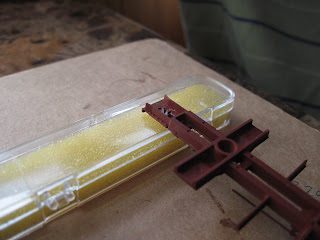 |
| Original coupler pocket. Photo by Steven Ogden. |
Typically, inside the coupler pocket on most HO scale freight cars, there is a round peg that holds the coupler in position. This allows it to swing from side to side, but usually it occupies most or all of the mounting hole in the coupler. I use Sergent Engineering couplers on my cars, which have a round mounting hole, with a rectangular slot on the knuckle end of the hole. By trimming the sides off the mounting pin, this will allow the coupler to slide in and out, while still allowing it to swing from side to side and holding it in the right place. These modifications will work best with Sergent couplers, but they could be adapted for just about any type of coupler.
 |
| Modified mounting pin. Photo by Steven Ogden. |
To do this you will need a hobby knife or similar cutting tool. You will also need a small spring for the cushioning effect. If you are using Sergent couplers, you know they come with a small spring, and those work just fine. For those of you who do not use Sergent Engineering couplers, the springs are available for sale on their website. They should work just fine, regardless of what coupler type you are using.
Since the Sergent couplers already have a slot in them, in addition to the mounting hole, I cut the mounting pin down small enough to fit into that slot. This will restrict side to side movement of the coupler when the drawbar is compressed, but on model trains, they serve very little useful purpose anyway!
 |
| Cushioned drawbar, with the coupler pocket still open. Photo by Steven Ogden. |
Once you have tripped the mounting pin to the appropriate size, it is time to put the coupler and spring in. Inserting such a small spring can be a little tricky. I find it is easiest to do with a small flat head screwdriver. You can insert the screwdriver into one end of the spring, and then insert it at an angle. Once it is in position, the screwdriver should come out without disturbing it significantly. At that point, you will want to close up the coupler pocket before testing. Testing it with the pocket still open could result in the tiny spring flying out and being lost forever! Once you close it up, make sure to test it. It will work best with the coupler centered. If it works, put the car back together and enjoy! If you notice that it is hanging up or is not working, you may have to open the coupler pocket again and make sure the modifications to the mounting pin are clean. If there is any plastic that has not been removed properly, it could catch on the coupler and prevent it from working properly. Chances are if the coupler does no work properly right away that is the problem.
Once the cushioned drawbars are complete, you will have protection from coupler slack for your model railroad loads. However, because model railroad cars weigh so little, the cushioning will have very little effect on overall train handling. In fact, unless your cushioned car is the first in a long train, you will hardly notice it! If you put a couple of cushioned cars ahead of about 20 other cars, and then shove hard, you'll notice the drawbars absorbing some of the force, but they only work under extremes on the model railroad.


No comments:
Post a Comment